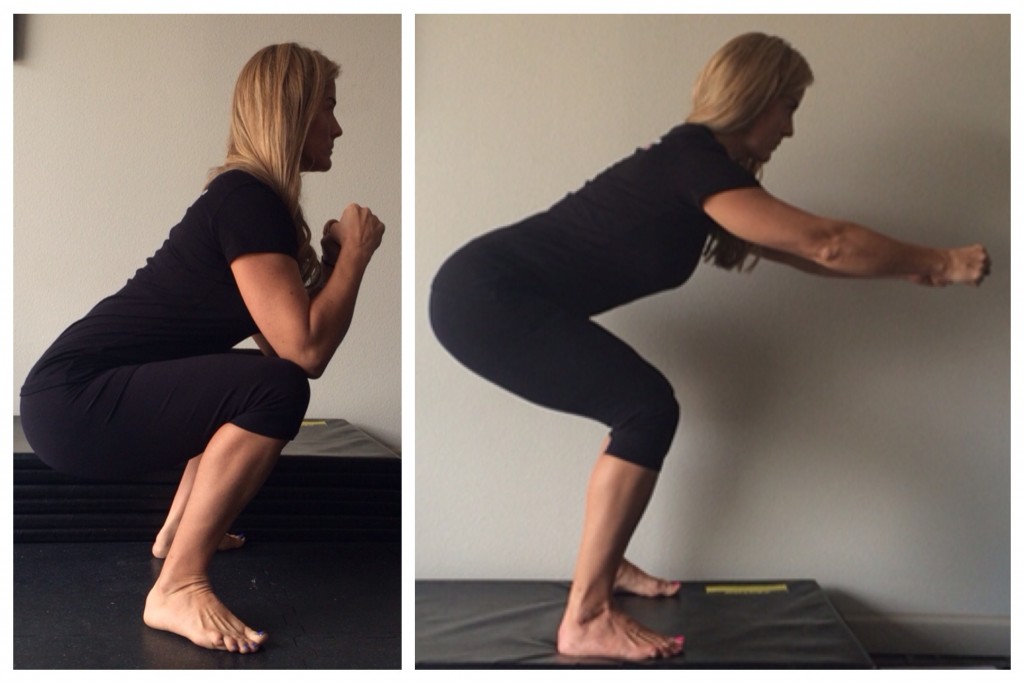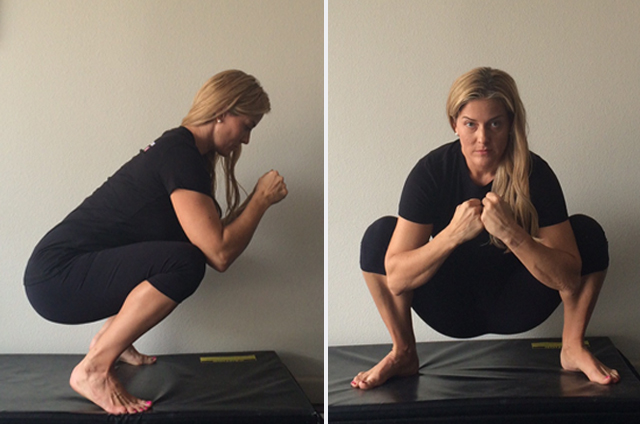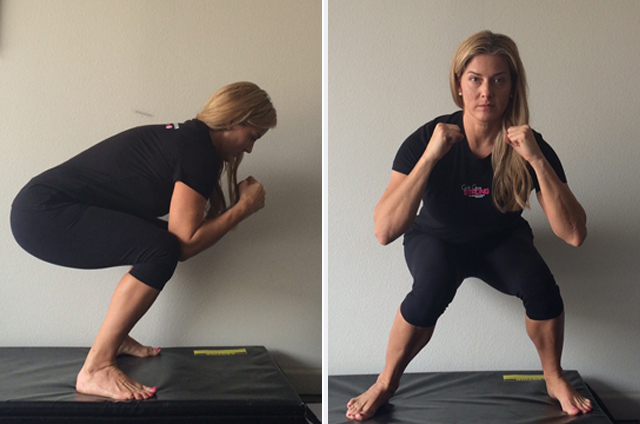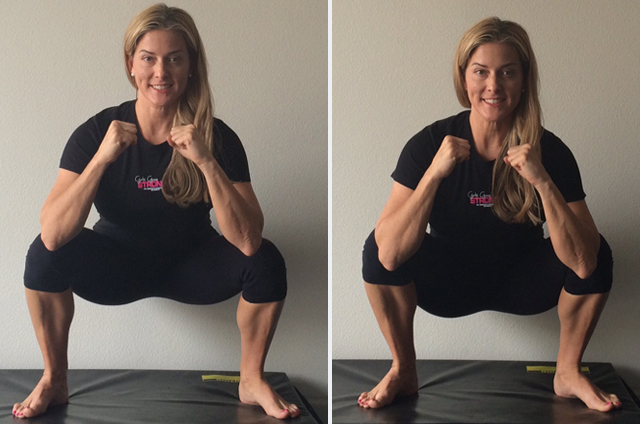https://www.girlsgonestrong.com/
(Note from GGS: Before we get any hate mail, yes, we LOVE Hip Thrusts for building a bigger and better booty as well, and plan to have an article about them very soon! Stay tuned! )
On numerous occasions my students and clients have walked into the Lululemon store in the town where I used to live, and they’ve immediately been asked, “where do you train?”
When they would answer, “Kettlebell Elite,” (the gym I owned at that time), the women would always respond with, “All of the women who train there have the best butts!”
Why do my students have the best butts? Because they squat and they squat often.
Squats are a natural and safe movement that almost all of us are capable of performing as children. Aaaand then we grow up and often lose the ability to squat well. We can lose our ability to squat well for a number of reasons, including but not limited to: lack of physical activity, sitting throughout the day, joint or muscle stiffness, lack of stability, previous injuries, and more.
Squats are great fundamental movement for improving mobility, stability, and strength, and they have tons of real world carryover. What about a better bum? In my experience, heavy squats are fantastic for increasing and lifting your ASSets.
I’ve yet to meet a woman who didn’t appreciate the higher, tighter, lifted glutes that come from adding squats to their program. In the kettlebell community we call this result a “bell butt.”
Before we discuss the various squat variations, let’s talk about squat form.
The main difference in a squat and a hinge (deadlift or swing pattern) is that while they both require a nice, flat back, the shoulders and hips should descend and ascend at the same rate when squatting. While in a hinge the hips hinge back and the shoulders stay much higher.

Left: Squat; Right: Hinge
You may have heard the old adage, “don’t squat past parallel because it’s bad for your knees.” However, the truth is, squats, and even deep squats, are not bad for your knees. Squatting with bad form is bad for your knees. If you’d like to learn more about that, check out this article from fellow Girls Gone Strong Advisory Board Member and Physical Therapist Ann Wendel: Do Deep Squats Cause Knee Pain?
“Rock bottom” (i.e. deep) squats are perfectly fine when performed with proper technique. Most often when I see people stop at parallel, they are actually putting more pressure and stress on their knees by leaning forward with their knees too far forward over their toes, instead of sharing the load among their hips, glutes, quads, hamstrings, and knees.
Below are some examples of improper squat form:

- Left: Improper due to heels being raised, you may see this if you are lacking in ankle mobility.
- Right: Improper due to rounding of the back and hunching over which drops the elbows past the knees.

- Left: Improper due to rounded back.
- Right: Improper due to valgus collapse (knees caving in) or Pronating (ankles caving in)

- Left: Approved Squat
- Right: Proper Depth for Deep Squat
While the photo on the right above shows proper depth for a deep squat, I would currently stop short of this depth. Notice the current asymmetry in hip level. This would cause a dysfunctional squat pattern at this time. Always a good idea to have a coach or take a video of yourself to check your form.
If you feel pain when squatting, read Ann Wendel’s recent article on deep squats and knee pain.
I often see people stop short when squatting or say, “I can’t squat.” While sometimes this may truly be the case for some, most often it isn’t. After doing a few assessments and drills, we can determine if it is a mobility issue in the hips or ankles or if they are just afraid of squatting.
At a recent workshop that I was teaching I had a student that was not squatting down to parallel. I began asking questions and assessing her body to determine the issue. After a few drills and more questions, I found out that it was just a fear of falling backward. The following video will demonstrate how to help someone get lower and determine if they have the proper mobility to squat deeply.
In order to get into a proper deep squat:
- sit down (pulling your butt between your knees)
- knees should track your in line with your toes
- hip joint should be past your knee joint
- back should be flat (no rounding in the t-spine or lumbar)
- pressure on your whole foot (keeping your toes gripping the ground
- maintain glute and core tension
Note – If you are super mobile and can easily squat to rock bottom and hang out there while relaxed, you may be losing some of the benefit of the deep squat. Try stopping 1 inch higher where you can still maintain the tension in your legs, glutes, and core.
Now that we’ve covered the technique, lets discuss the best place to start squatting or have your students or clients start squatting. I recommend that you always pattern a move with your own bodyweight prior to loading it with a weight (kettlebell, dumbbell, or barbell). I begin with an assessment first, like “Face The Wall Squats,” then proceed to loading the squat in a variety of ways. Below are a series of videos to illustrate this process:
FACE THE WALL SQUAT (bodyweight)
SUMO FACE THE WALL SQUAT (loaded)
KETTLEBELL GOBLET SQUAT
KETTLEBELL FRONT SQUAT (Single vs. Double)
KETTLEBELL PISTOL (bodyweight/loaded) vs. SINGLE LEG SQUAT (box)
My preference is to normally train low reps with heavy weight. An example of this would be 5 sets of 5, however with the tremendous amount of travel I am doing these days I also do a lot of bodyweight training. Below I have added a Bonus Bodyweight Squat workout that you can do while traveling or anytime you see fit. Weight can also be added to this workout over time.
BONUS: Bodyweight Squat Ladder workout
This workout is great when you are traveling or maybe even try it loaded sometime to make it more advanced. Start this workout at the top of a 10-rung ladder. You will do each rung then rest before going to the next rung, it may not seem like you need the rest at first but I promise it will catch up with you. Each rep you will pull yourself to a rock bottom squat, come up ½ way then go back down to rock bottom then stand to equal one rep.
After you have finished the first 5 rungs (10-6) we change it up for the last 5 rungs (5-1). For the last rep of each of these rungs you will add a hold at the last ½ mark. Each rung the last rep hold gets longer.
10 reps – rest
9 reps – rest
8 reps – rest
7 reps – rest
6 reps – rest
5 reps (4 reps, then on #5 Hold 10 sec at ½ way point, then down, then up)
4 reps (3 reps, then on #4 Hold 15 sec at ½ way point, then down, then up)
3 reps (2 reps, then on #3 Hold 20 sec at ½ way point, then down, then up)
2 reps (1 rep, then on #2 Hold 25 sec at ½ way point, then down, then up)
1 rep (rock bottom, then ½ way up, Hold 30 sec, then down, then up)
Filed under: Fitness

 For now classes are 6pm and 640pm at 2840 Wildwood st in the Boise Cloggers studio.
Book your class NOW!
click this ==>
For now classes are 6pm and 640pm at 2840 Wildwood st in the Boise Cloggers studio.
Book your class NOW!
click this ==>








